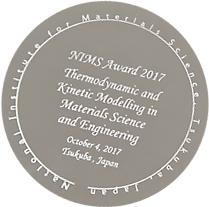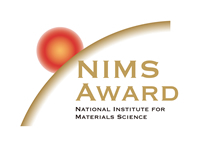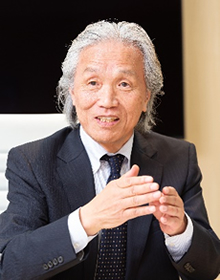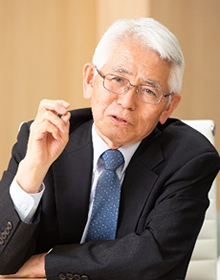NIMS Award 2018
2018 Award Winners
This year, NIMS will present the honor to an outstanding research achievement in the field of Functional Materials in particular the materials innovation which has led to magnetic and spintronic application or the basic research achievement which has triggered the innovation. Dr. Masato Sagawa invented the world's strongest neodymium magnet that is now used for motors for EVs and HDDs, and Prof. Terunobu Miyazaki invented the room temperature tunneling magneto-resistance device that led to real spintronic applications such as read sensors in HDDs and memory cells in MRAMs.
Research Achievment
Winners Profile
| Research field | Permanent magnet materials |
|---|---|
| Research achievement title | Invention and practical application of neodymium magnets |
| Research summary | Dr. Sagawa invented neodymium (Nd) magnets—the world’s strongest magnets—and led the industrialization of anisotropic neodymium magnets through a powder metallurgy process. The use of these magnets enabled the development of various electronic devices, such as hard disk drives, hybrid and electric vehicles. Dr. Sagawa independently discovered Nd-Fe-B-based magnetic alloys as a promising permanent magnet material. Immediately after joining Sumitomo Special Metals Inc., Dr. Sagawa developed the world’s strongest Nd-Fe-B-based magnet. He then applied for a patent under the name of Sumitomo Special Metals in 1982 and published the approved patent in 1983. The development of Nd sintered magnets was revolutionary not only because their magnetic fields were stronger than those of the previously strongest Sm-Co-based permanent magnets, but also because they are composed mainly of Fe, which is abundant in nature, and Nd, which is a relatively abundant rare-earth element. The discovery of neodymium magnets was also groundbreaking because it defied the common belief that cobalt is a requisite ingredient in permanent magnets and completely resolved the issue of the limited availability of Co resources. Nd magnets remain the world’s strongest 35 years after their invention, and their applications, which now include electric vehicles and robotics, continue to grow. |
| Impact on the academic and industrial sectors | Dr. Sagawa not only invented the anisotropic neodymium magnet, but also promoted basic research on the neodymium magnets by supplying samples to academic researchers around the world. This effort greatly contributed to advances in materials science of permanent magnets. Sumitomo Special Metals began commercial production of the Nd-Fe-B sintered magnet product NEOMAX in 1985. Production of NEOMAX—the most powerful permanent magnet in the world which can be manufactured using inexpensive raw materials—rapidly increased as the range of its applications expanded. Approximately 70,000 tons of NEOMAX were estimated to have been produced worldwide in 2015. Used in hard disk spindle motors and head actuators, neodymium magnets have become indispensable components of modern data storage technologies. More recently, Nd magnets have been used in the motors and generators of hybrid and electric vehicles, wind power generation, energy-efficient air conditioners and the drive units of robots. The use of these magnets for these purposes is expected to continue growing. Thus, society has benefited immensely from the neodymium magnets. For this contribution to the society, Dr. Sagawa received many prestegous awards like Osaka Science Award, James C. McGroddy Prize for New Materials, Asahi Prize, Honda Memorial Award and Japan Prize. |
| Research field | Spintronics, magnetic materials |
|---|---|
| Research achievement title | Development of tunneling magnetoresistance devices capable of generating giant magnetoresistance at room temperature and application thereof to spintronics devices |
| Research summary | A magnetic tunnel junction (MTJ) is a tri-layer structure composed of two ferromagnetic layers sandwiching an insulating layer. Tunnel magnetoresistance in MTJ changes in response to differences in magnetic orientation between the two ferromagnetic layers, i.e., the tunneling magnetoresistance (TMR) effect. Although the TMR effect was first reported as early as the 1960s, observations prior to Prof. Miyazaki’s pioneering research on TMR devices at Tohoku University were limited to the detection of subtle TMR at extremely low temperatures. In 1995, Prof. Miyazaki observed a giant TMR effect at room temperature for the first time using tri-layer (Fe/alumina/Fe) magnetic tunnel junction. This success triggered the interest in the practical application of TMR devices. After demonstrating the successful operation of TMR device at room temperature, Prof. Miyazaki continued his research by collaborating with worldwide academic and industrial researchers. His contributions were crucial in the development of spintronics. TMR is now used as read sensors of high capacity hard disk drives, magnetic random access memories and other magnetic sensors. Prof. Miyazaki’ greatly contributed to society by advancing the applications of TMR devices in data storage, nonvolatile magnetic memories and magnetic sensors. |
| Impact on the academic and industrial sectors | Prof. Miyazaki’s observation of a magnetoresistance effect at room temperature using TMR devices had a profound impact on the academic and industrial sectors. TMR devices were put into practical use in high-sensitivity read heads for hard disk drives (HDDs), which were commercialized in 2001 and still in use today. The improved performance of TMR read heads enabled an increase in HDD recording density, from tens of Gbit/in2 before 2001 to 1 Tbit/in2 today, greatly increasing the storage capacity of HDDs, which now serve as vital infrastructure for our advanced information society. TMR elements are also used as memory cells in MRAM devices, a promising candidate for next-generation non-volatile memory. The global R&D effort to develop these technologies has its roots in Prof. Miyazaki’s discovery. The room temperature TMR effect has been applied in a wide variety of engineering and scientific research projects, such as exploration of high spin polarization materials and magnetically anisotropic materials and spin torque generated by spin transport. These research projects were highly valued by academic and industrial groups and won many awards, including the Asahi Prize, the JSAP (Japan Society of Applied Physics) Award and the American Physical Society Award. As a longtime faculty member at Tohoku University, Prof. Miyazaki has educated many students and young researchers in the magnetism and spintronics field. He has contributed greatly to maintaining Japan’s high research standards in this field. |
About the NIMS Award

This year, NIMS will honor achievements in the field of "Structural Materials".
Past Winners
2017
Prof. John Ågren
Prof. Bo Sundman
Dr. Kiyohito Ishida
2016
Dr. Koichi Mizushima
Dr. Akira Yoshino
2015
Prof. Harald Rose
Prof. Maximilian Haider
Prof. Knut Wolf Urban
2014
Prof. Krzysztof Matyjaszewski
Prof. Mitsuo Sawamoto
2013
Prof. Hideo Hosono
2012
Prof. Harry K.D.H. Bhadeshia
Prof. John William Morris, Jr.
Prof. Subra Suresh
2010
Prof. Jean Marie Tarascon
2009
Dr. Kazunori Kataoka
2008
Prof. Anthony G. Evans
2007
Prof. William H. Butler


